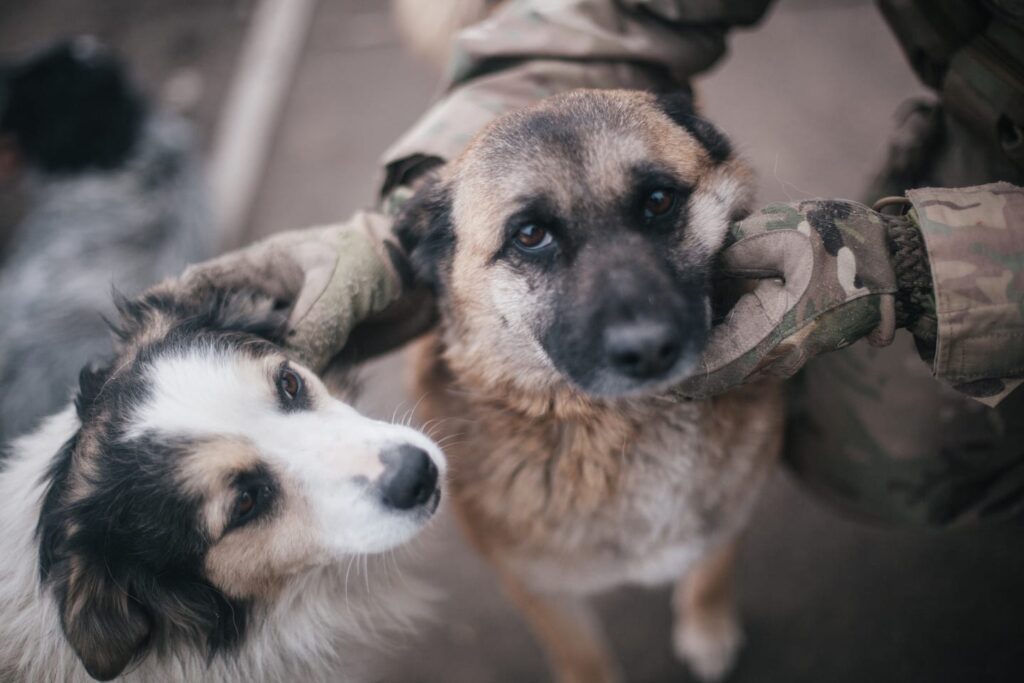War Dogs: Our Salute to 4 Types of Military Dogs

It is intelligence and athleticism that have made war dogs essential on the battleground. They give up their lives in numbers while they save thousands upon thousands of others. These war heroes aren’t new additions to our military either. In United States history, war dogs have been fearless warriors, partners and rescuers for over 100 years. However, they were not officially acknowledged as part of the armed services until World War II, when 10,000 specially trained military dogs were deployed.
When American Military went to Vietnam, hundreds of working dogs were deployed. Within a year, enemy attacks on American bases stopped when the Vietcong discovered dog teams. The Vietcong feared military dogs so much that they placed a bounty on the lives of both the dogs and their handlers. The United States War Dogs Association estimates that over 10,000 American lives were saved in Vietnam by man’s best friend.
Over the years, several types of canines served as military working dogs, but more recently, the majority are German Shepherds, Dutch Shepherds and Belgian Malinois. It’s an interesting juxtaposition that these working dogs are chosen because of their unyielding affection and devotion to their partners, as well as their ability to bite with a force between 400 and 700 pounds.
Different military dogs have different skills, but in total they complete the following duties:
Sentry Dogs
This type of military dogs gives warning and is extremely valuable while working in the dark or alerting soldiers of attacks from behind. Sentry dogs were even used by the Coast Guard in World War II as coastal fortification guarding against enemy submarine activity.
Scout or Patrol Dogs
These dogs detect snipers and ambushes. They are trained to work in complete silence. Just the mere presence of dogs on patrol greatly decreased the possibility of an ambush, which in turn was a morale boost for the troops.
Messenger Dogs
These canines require extreme loyalty, as they must be trusted to go from one handler to another. They travel silently and are able to use natural cover.
Casualty Dogs
These war heroes are trained to search and report casualties in obscure locations. Their ability to identify an injured soldier who needs immediate attention has saved countless lives. In current wars, the dogs are outfitted in protective armor as well as small cameras making it possible for their handlers to send the dogs at least 1,000 feet ahead of them to get a look at what they’re up against. Again, these dogs put their loyalty and obedience ahead of fear.
The war dogs’ very presence on a military base has an uplifting effect on the troops. These innocent pups will play ball with them and lick their faces in one moment, and ferociously defend them with their lives in the next. But it is these war heroes’ unmatched ability to sniff out explosives that may technically save the most lives. Millions of dollars have been spent on technology that can detect bombs, but none come close to the detections made by military working dogs and their handlers.
Like any good partnership, many of the soldiers assume a short hand with their four-legged partners. Some handlers have even claimed their dogs share their personality or think the same way they do. Out in the fight against terror, the dogs and their soldiers even begin to resemble each other, covered in desert dust as they trudge together in combat.
That’s why it’s no surprise that even the toughest soldiers have been known to shed tears when their time with their service dog comes to an end. After all, these dogs truly live up to their K9 Promise:
My eyes are your eyes. To watch and protect you and yours. My ears are your ears. To hear and detect evil minds in the dark. My nose is your nose to scent the invader of your domain. And so you may live, my life is also yours.
Dogs also play a pivotal role in soldiers’ lives after they return from combat. You can read our article on service dogs who help veterans with PTSD here.


